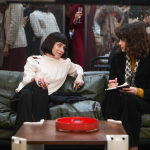
Why is it so hard to talk about fashion in TV series?
"Made in Italy" and the limits of stories about fashion seen on TV
January 20th, 2021
«Welcome, Irene, to the wonderful world of fashion. Beware, once inside, it's going to be impossible to get out of it», says Walter Albini with a theatrical gesture, just before a slideshow of photos that portray the real Albini with a voice-over dialogue with ludicrous lines like «But Rita, so he's an innovator?» «We can safely declare that he is the father of prêt-à-porter at least in Italy», followed by a dream: «In short, he was very important».
In this short exchange of lines hide all the perplexities that Made in Italy arouses. It's a tv show that Prime Video produced in 2019 but arrived only recently on Canale 5, and is the Italian response, one would say, to Emily In Paris with in addition a certain historical-documentary approach. Both series decide to tell fashion not from the point of view of designers but from that of publishing, with female protagonists who find themselves working in important newsrooms that become the privileged point of view to observe the fashion scene and its fauna. But the representation of fashion that often comes out of it always remains something didactic or too over the top.
The origin of the problem dates back to the most iconic fashion film of the last twenty years, namely The Devil Wears Prada, which has set the narrative parameters of the genre: a naïve protagonist and stranger to fashion finds herself catapulted into the new world, her challenges will be personified by bosses and snobbish colleagues on the edge of bullying but she will eventually succeed thanks to her good heart and her reward will be a love story or a promotion, or both. This kind of archetypal plot worked perfectly for The Devil Wears Prada because it was the first time we saw this storytelling. The second or third repetition already falls into the cliché – a sin much lamented by Emily in Paris's critics, although the series remains more or less aware of its semi-fairytale nature. Different discourse must be made for Made In Italy, a series that tells not the scene of modern fashion, but chooses as the background that epic cultural saga that was the birth of Milan as the capital of Italian fashion with all its protagonists: Walter Albini, Krizia, Giorgio Armani, Elio Fiorucci, Gianni Versace, Gianfranco Ferrè, the Missoni family and so on.
It was the choice to make that Milan only a scenic backdrop and not a direct protagonist of the story that disappointed the audience. The documentary inserts put forcefully into the narrative are the only ones charged with telling (briefly) the stories of the great designers who then, during the episodes, are labelled as "innovators" without too many explanations. The past is also reconstructed with a certain authenticity (the legendary fashion journalist Adriana Mulassano was a historical consultant for the production) but told to the public in such a sweetened and generalized way that it does not do justice to its protagonists. However, it must be recognized that the turbulent Milan of the post-68, between political crises, student protests and the start of the Lead Years, would be very difficult to tell in full, even from the point of view of fashion alone, as a generalist fiction – and for this reason, Made In Italy does an honest job. Yet that same story is too interesting, too full of episodes and details perfect for understanding today's world to not deserve a better narrative.
Talking about fashion on TV is difficult because fashion is something that defies conventions (or should). To quote the same Made In Italy: «To really provoke, one must go the distance». And a TV series about fashion should know how to provoke exactly how fashion does, have depth and perspective, tell the world not with the eyes of the intern of good hopes, but with the "internal" gaze of a photographer, a model or a designer; talk about its subcultures and describe an aesthetic that is closer to reality (see, the outfits of the protagonist of We Are Who We Are, the Luca Guadagnino series), but also deepen and contextualize its role in a significant way and not with the hastiness of a press release. Waiting for that moment, you have to settle for the fashion of Made In Italy: scholastic but at least heart-warming and full of good intentions.




































.jpg)










.jpg)







.jpg)
.jpg)





































